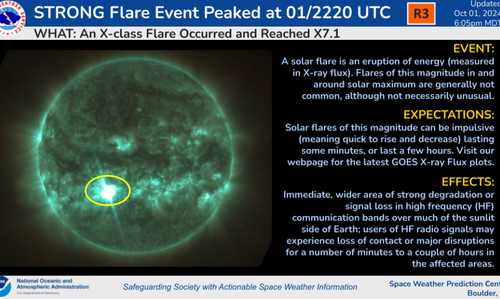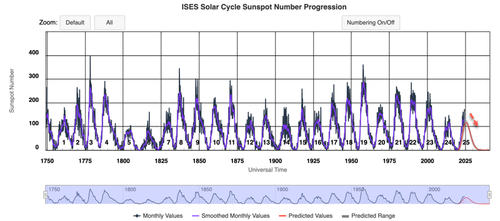
Sun Burps Second-Biggest Solar Flare Of Cycle 25 As Impact Analysis Says Earthbound By Weekend
NOAA’s Space Weather Prediction Center detected an X7.1 solar flare on Tuesday, the second strongest of Solar Cycle 25. It originated from Active Region 3842. The most powerful flare of the cycle, an X8.7, occurred earlier this year on May 14.

„This latest flare was observed by the GOES-16 satellite X-ray sensor (XRS) and peaked at 6:20 pm EDT (2220 UTC). The flare was impulsive in nature but was associated with some USAF solar radio observatory reports that may indicate a possible coronal mass ejection (CME) could be associated with the flare,” SWPC wrote in a space weather update.
Wow! An X7.1-class solar flare — the second-biggest of Solar Cycle 25 — just launched off the Sun from sunspot AR3842.
The next step is to wait to see if a CME, or coronal mass ejection, accompanied the flare. If so, it will probably be earth-directed. pic.twitter.com/fjoAxC5b3b
— Matthew Cappucci (@MatthewCappucci) October 2, 2024
An update on space weather website SolarHam notes the solar flare was a „faint halo CME was associated with the X7.1 solar flare around AR 3842 Tuesday evening. Although not an overly energetic event, a passage past Earth will still be likely within 48-72 hours.”
An X7.1 (R3) solar flare erupted from Region 3842 this evening – as seen in this animation (courtesy of jhelioviewer). This was the second strongest flare of Solar Cycle 25, only bested by an X8.7 flare on May 14th of this year. See https://t.co/MiukLmxbua for full story. pic.twitter.com/Qohhyk17DW
— NOAA Space Weather Prediction Center (@NWSSWPC) October 2, 2024
X user EarthSky wrote this morning, „Yesterday evening’s giant X flare released a chunk of sun-stuff – a coronal mass ejection, or CME – toward Earth. Initial analysis says it should arrive October 5,” adding, „It is a relatively fast but not a very big CME.”
Yesterday evening’s giant X flare released a chunk of sun-stuff – a coronal mass ejection, or CME – toward Earth. Initial analysis says it should arrive October 5. It is a relatively fast but not a very big CME.
Read EarthSky’s daily sun news: https://t.co/dVTIcoTvEg pic.twitter.com/2prs4z2sea
— EarthSky (@earthskyscience) October 2, 2024
SPWC expects a minor to moderate solar storm by the end of this week or the weekend. In other words, auroras will be visible in certain areas.
As we’ve previously noted, the solar maximum has arrived.

Last year, we pointed out that Cycle 25 is expected to peak sometime in 2025.
- Solar Cycle 25’s Maximum Might Arrive Earlier And Hit Harder
It was noted that the 'first traces’ of Solar Cycle 26 had been detected.
„First Traces” Of Solar Cycle 26 Detected On Sun https://t.co/8GTR5vJh1M
— zerohedge (@zerohedge) July 21, 2024
In early May, one of the most powerful solar storms in years blasted Earth. Fortunately, the digital economy held up, and Starlink’s massive satellite constellation also survived.
- US Power Grid & Communication Networks Survive Extreme Geomagnetic Storm
Let’s remember we’ve outlined just how fragile modern society has become in a solar maximum period of heightened Earth-facing space weather.
-
Digital Economy Disruption Possible As „Terminator Event” Suggests Strongest Sunspot Cycle On Record Imminent
-
The Next Big Geomagnetic Storm Poses An Astronomical Risk To Modern Man
-
Solar Storms Can Devastate Entire Civilizations.
-
Solar Storms Present Danger Of Blackouts For Major East Coast Cities
-
Washington DC Most Vulnerable US City For Grid Failure During Geomagnetic Storm

Maybe the biggest threat to civilization is not the human-caused global warming narrative pushed by far-left corporate media outlets and progressive elected and unelected officials; instead, look to the sky. But then again, somehow, the climate alarmist will twist words and find a way to blame the sun-burping plasma on humans.
Tyler Durden
Thu, 10/03/2024 – 04:15

 11 miesięcy temu
11 miesięcy temu












